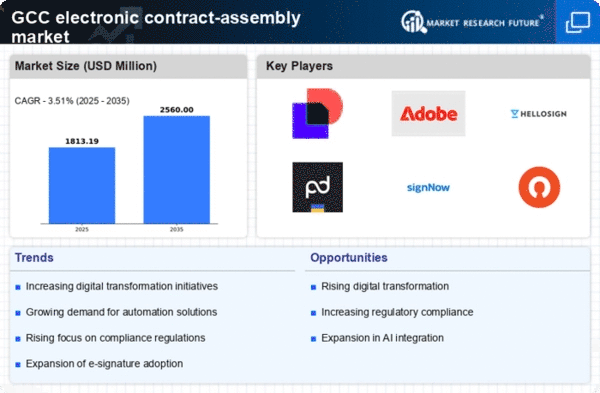The electronic contract-assembly market is currently characterized by a dynamic competitive landscape, driven by rapid technological advancements and increasing demand for streamlined digital solutions. Key players such as DocuSign (US), Adobe (US), and PandaDoc (US) are at the forefront, each adopting distinct strategies to enhance their market positioning. DocuSign (US) focuses on innovation through continuous product enhancements, while Adobe (US) leverages its extensive suite of creative tools to integrate contract solutions seamlessly. PandaDoc (US) emphasizes user experience and customization, which appears to resonate well with small to medium-sized enterprises. Collectively, these strategies contribute to a competitive environment that is increasingly defined by technological integration and customer-centric solutions.
In terms of business tactics, companies are increasingly localizing their operations to better serve regional markets, optimizing supply chains to enhance efficiency. The market structure is moderately fragmented, with several players vying for market share, yet the influence of major companies remains substantial. This fragmentation allows for niche players to emerge, fostering innovation and competition, while larger firms leverage their resources to maintain a competitive edge.
In October 2025, DocuSign (US) announced a strategic partnership with a leading AI firm to enhance its contract analytics capabilities. This move is likely to bolster its offerings by integrating advanced data insights, thereby improving user decision-making processes. Such partnerships may not only enhance product functionality but also position DocuSign (US) as a leader in AI-driven contract solutions, potentially attracting a broader customer base.
In September 2025, Adobe (US) launched a new feature within its Document Cloud that allows for real-time collaboration on contracts. This strategic enhancement is indicative of Adobe's commitment to fostering collaborative environments, which could significantly improve user engagement and satisfaction. By prioritizing real-time functionalities, Adobe (US) appears to be addressing the evolving needs of businesses that require agility and responsiveness in contract management.
In August 2025, PandaDoc (US) expanded its operations into the Middle East, establishing a regional office to cater to the growing demand for electronic contract solutions. This expansion reflects a strategic focus on regional growth and localization, which may enhance PandaDoc's (US) ability to tailor its offerings to meet specific market needs. Such moves are likely to strengthen its competitive position in a rapidly evolving market landscape.
As of November 2025, the competitive trends in the electronic contract-assembly market are increasingly shaped by digitalization, sustainability, and the integration of AI technologies. Strategic alliances are becoming more prevalent, as companies recognize the value of collaboration in enhancing their service offerings. Looking ahead, it is anticipated that competitive differentiation will increasingly pivot from price-based strategies to innovation, technological advancements, and supply chain reliability. This shift underscores the importance of adaptability and forward-thinking in maintaining a competitive edge in the evolving market.

















Leave a Comment